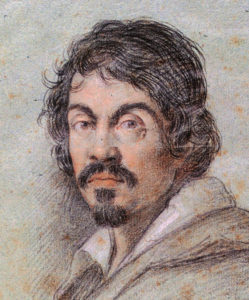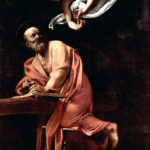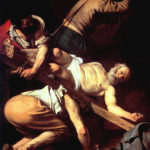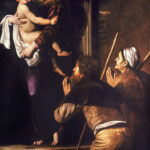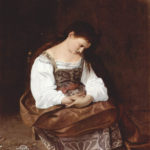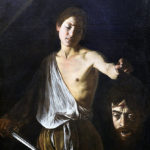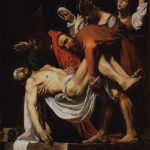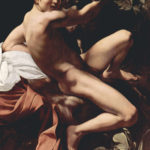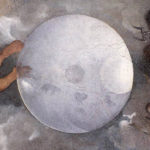Caravaggio: His Influences and Style
Michelangelo Merisi, known as Caravaggio, born on September 28, 1571, in Milan and died on July 18, 1610, in Porto Ercole, was an Italian painter active in Rome, Naples, Malta, and Sicily. His work revolutionized the painting of his time by combining a realistic observation of human figures, both in their physical and emotional dimensions, with a dramatic use of light and shadow (chiaroscuro).
His influence was decisive in the emergence of the Baroque, breaking away from the Mannerism from which it originated. He was the originator of Caravaggism, inspiring major artists such as Peter Paul Rubens, Jusepe de Ribera, Gian Lorenzo Bernini, and Rembrandt. A generation of painters, known as the Caravaggists, adopted his use of chiaroscuro and theatrical staging, contributing to the spread of Baroque in Europe. Among them were Artemisia Gentileschi, Gerrit van Honthorst, and Georges de La Tour.
Caravaggio transformed lighting into a central element of his art, intensifying contrasts and immersing his figures in striking beams of light. His works convey intense moments of tension and crucial scenes, often marked by drama, conflict, or death. Unlike the idealized aesthetics of the Renaissance, championed by artists like Titian or Michelangelo, he favored a raw and realistic depiction of the world, breaking with Mannerist conventions.
He painted quickly, directly on the canvas, and used live models, giving his works a striking presence.
Training in Milan and Rise in Rome
Before settling in Rome in his twenties, Caravaggio trained in Milan under the influence of the Lombard school and with Simone Peterzano, a disciple of Titian. This training, marked by rigorous naturalism and work with light, shaped his realistic approach and innovative use of luminism.
His talent quickly earned him success and prestigious commissions. He was supported by influential figures such as Cardinal Francesco Maria del Monte, who provided him with lodging in Rome and commissioned major works from him.
A Restless Artist with Many Enemies
Caravaggio often had tumultuous relationships with his patrons and peers. His impetuous and fiery temperament led to numerous conflicts, notably with the painter Giovanni Baglione, whom he publicly ridiculed through satirical poems. The latter sued him for defamation in 1603.
His volatile character and violent behavior led to several imprisonments, though his protectors often helped him avoid harsher penalties.
In 1606, following a duel or altercation that resulted in the death of his opponent, Caravaggio was convicted of murder. Forced to flee Rome, he found refuge in Naples, then Malta and Sicily. During this exile, he continued his work while seeking papal pardon, producing numerous paintings as acts of repentance.
Returning to Naples in 1609, he was again involved in a violent confrontation and was seriously injured. According to some accounts, his face was disfigured.
Mysterious Death and Legacy
Caravaggio died in 1610 under still uncertain circumstances. Officially, he succumbed to a fever while traveling from Naples to Rome, after an unexplained stop in Porto Ercole. Theories suggest assassination or lead poisoning. In 2010, analysis of his remains found in Porto Ercole confirmed the location of his death, though the exact cause remains unclear.
Long forgotten after his death, his work was fully rediscovered in the 20th century. Since then, his influence on Western art and his role in the evolution of modern painting have been widely reassessed.
Discovering Caravaggio in Rome
Today, several of Caravaggio’s masterpieces can be seen in Rome’s churches and museums. A tour through the historic center allows visitors to admire his iconic paintings, testaments to his genius and revolutionary vision of painting.
Caravaggio in Rome’s Churches
The Saint Matthew Triptych at San Luigi dei Francesi (Saint Louis of the French): The Calling of Saint Matthew, The Martyrdom of Saint Matthew, and Saint Matthew and the Angel. One of the most significant commissions of Caravaggio’s career was the decoration of the Contarelli Chapel in 1599, in the Baroque church of Saint Louis of the French, near Piazza Navona.
Caravaggio created a series of three paintings dedicated to the figure of Saint Matthew.
These works gained great prestige upon their installation.
Saint Matthew and the Angel (1602) was redone by the artist after the rejection of a first version by his patrons. It depicted the saint as a bald man with dirty legs, struggling to write, assisted by an angel guiding his hand. This painting was destroyed during World War II, but photographic reproductions remain.Two Caravaggios at Santa Maria del Popolo
In the Basilica of Santa Maria del Popolo, two of the artist’s masterpieces from 1601 can be admired: The Conversion of Saint Paul on the Road to Damascus (in the Cerasi Chapel) and The Crucifixion of Saint Peter.
The original versions of these paintings were rejected. In the first version of The Conversion of Saint Paul, the saint appeared as a secondary figure overshadowed by the dominance of the horse in the composition. This work is now in a private collection of the Odescalchi Balbi family, occasionally exhibited. The first version of The Crucifixion of Saint Peter has been lost.Madonna of the Pilgrims in Sant’Agostino
The Madonna di Loreto (Madonna of the Pilgrims) is displayed in the Sant’Agostino church, painted between 1604 and 1606 for Ermete Cavalletti to adorn his family chapel.
Caravaggio in Rome’s Museums and Palaces
- Three Works at the Doria Pamphilj Gallery
The Doria Pamphilj Gallery houses three works by the artist.Repentant Magdalene (1594-1595, La Maddalena Penitente), Rest on the Flight into Egypt (1594-1595, Riposo durante la Fuga in Egitto), and Saint John the Baptist (1602, San Giovanni Battista).
The Magdalene was part of a set intended to decorate the salons of Caravaggio’s first patron, Cardinal Francesco del Monte. The model was a prostitute who also appears in The Death of the Virgin (now at the Louvre). Years later, she was found dead in the Tiber. - Six Works at the Borghese Gallery
The Borghese Gallery holds a significant collection of Caravaggio’s works: Boy with a Basket of Fruit (1593-1594), Sick Bacchus (1593, possible self-portrait), Madonna of the Palafrenieri (1606), Saint Jerome (1605-1606), Saint John the Baptist (1609-1610), and David and Goliath (1606-1607, Davide con la testa di Golia). In the latter, Caravaggio depicted himself as the decapitated giant.
- The Entombment at the Vatican Museums
The Entombment (1602-1604, Deposizione di Cristo) is the only Caravaggio work in the Vatican Museums, but it is of great beauty. It received unanimous approval (rare for Caravaggio) and much admiration from contemporary critics.
- Three Paintings at the Barberini Palace (Palazzo Barberini)
Narcissus (1597-1599), Judith Beheading Holofernes (1602, Giuditta e Oloferne), Saint Francis in Meditation (1605). The attribution of Narcissus is sometimes debated.
Judith Beheading Holofernes was famous at the time, shocking and surprising visitors at its original location due to its realism and rawness. Other painters later revisited the work, such as Artemisia Gentileschi (Judith Slaying Holofernes, 1620) and Francisco de Goya (Judith and Holofernes, 1820).
Narcissus is dated around 1597-1599. There is debate about its authorship.
Saint Francis in Meditation dates to 1605. Two Paintings at the Capitoline Museums
In the Capitoline Museums, one can admire one of the eight representations of Saint John the Baptist that the artist created during his lifetime, Young Saint John the Baptist with a Ram (San Giovanni Battista or Giovane con un montone), from 1602, with the same subject as the one in the Doria Pamphilj Gallery.
The painting The Fortune Teller (Buona Ventura), from around 1594-1595, is famous and often copied by other artists. A later version is exhibited at the Louvre Museum.- Saint John the Baptist at the Corsini Palace
This version of Saint John the Baptist (the fifth created by the painter) dates to around 1604. Its iconography is unusual. Mural Painting in the Villa Ludovisi
Jupiter, Neptune, and Pluto (Giove, Nettuno e Plutone), around 1597, 300 by 180 cm, a mural painting adorning a ceiling in the Casino of the Villa Boncompagni Ludovisi.
Caravaggio Itinerary in Rome
If you see this after your page is loaded completely, leafletJS files are missing.
Learn more about Caravaggio’s works:









